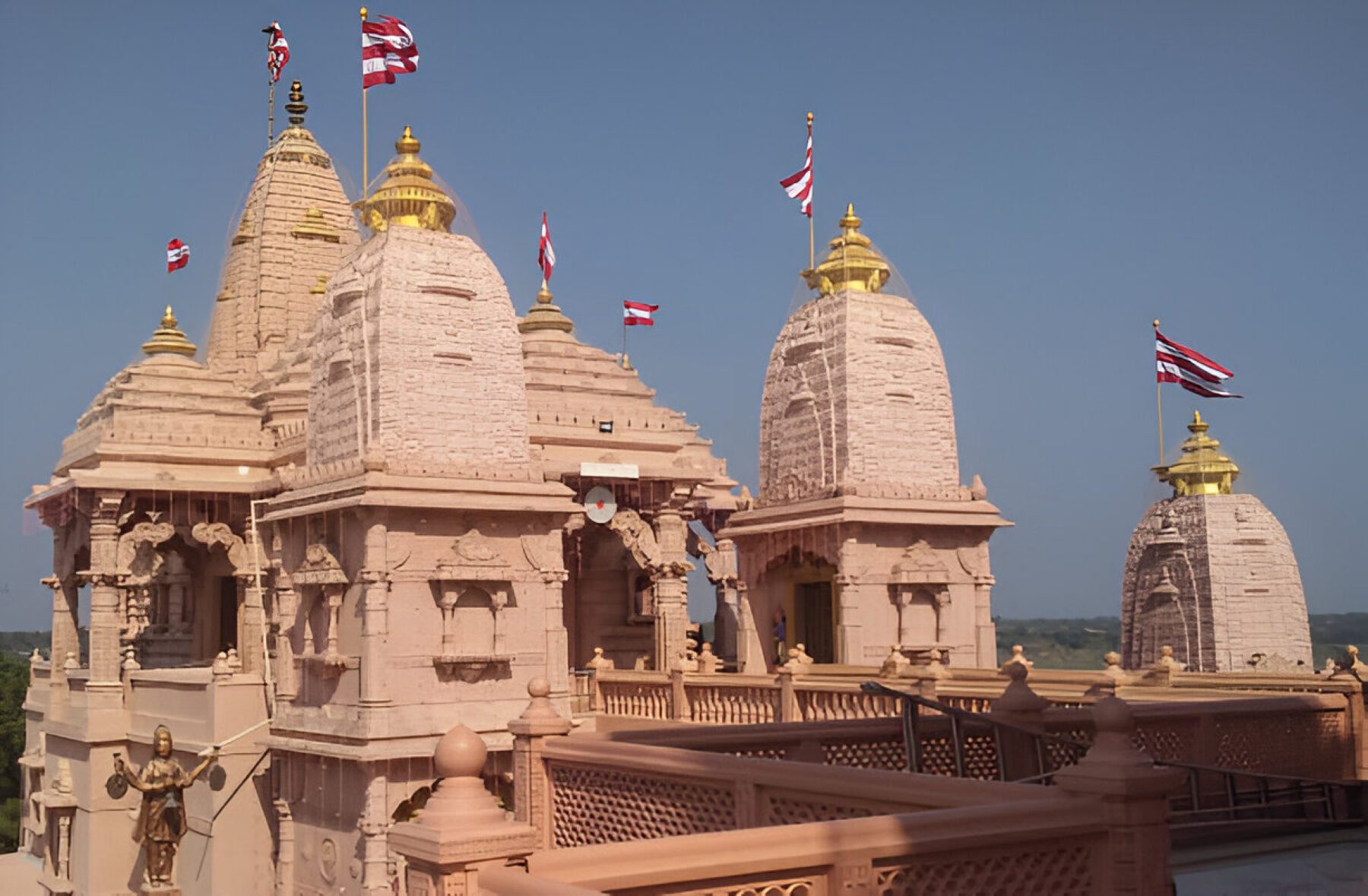Ayodhya is a place of many faces: culture, heritage, devotion– it’s a mix of calm, joy, and grandeur. History tags it sacred; it’s the birthplace of Lord Ram. Look at a map and you’ll find Ayodhya shining on the edge of the holy river Sarayu, in Uttar Pradesh. Ram Mandir, a standout spot on your Ayodhya itinerary, tells a silent story. It echoes with people’s feelings, showcases Indian architecture’s style, reflects the alluring customs, and embodies the city’s grandness.
Beyond the impressive temple, Ayodhya delivers more. With an array of sites to explore, you truly grasp Ayodhya’s spirit. Let’s start our adventure at the “Janmabhumi”.
1) Shree Ram Janmabhumi Temple
Picture a building without iron or steel today. It’s tough, right? But the Ram Mandir makes it real! It’s made entirely of pink sandstone, no iron or steel included. This temple holds immense importance in India. Standing grandly with three stories, each 20 feet high, 392 pillars and 44 doors hold it up. The design is magnificent, mixing Nagara-style architecture with Dravida-style elements.
2) Hanuman Garhi Temple
People often say that Lord Ram and Lord Hanuman go hand in hand. Likewise, your trip to Ayodhya isn’t complete without a stop at this temple. Built in the 10th century, it’s a sacred place dedicated to Lord Hanuman. It sits close to Ram Janmabhoomi. The main attraction? A 6-inch statue of a young(Bal) Lord Hanuman, nestled in the lap of his mother Anjani. A sight to see in this remarkable temple.
3) Sita ki Rasoi
This spot, thought to be Goddess Sita’s own kitchen, has an air of divinity. Found on the northwest side of the Ram Janmabhoomi, it’s a sacred site. Here, you’ll see statues of Ram, Lakshman, Bharat, and Shatrughan. Their wives – Sita, Urmila, Mandavi, and Shrutakirti, are also honored here. Legend says Sita cooked in this very place. Today, this old cooking and serving tradition lives on. Free, delicious meals are served as an open invitation to all.
4) Kanak Bhawan
Found to the north-east of Ramkot, this is a standout temple of Ayodhya. Queen Kaikeyi presented this temple to Lord Ram and Goddess Sita post-marriage. Story goes that Lord Krishna rebuilt this temple in Dwapar Yuga. This splendid Ayodhya temple wraps in once upon a time and culture.
5) Ram ki paidi
Picture yourself at Ram ki Paidi, watching the sun set over several serene ghats. Not just one, not two, but a string of them! These ghats line the bank of the River Sarayu, creating an unforgettable scene for those lucky enough to see it. It’s a top spot in Ayodhya for soaking in the sights. And if you like to capture moments with your camera, you’ll want to pay it a visit. Every day, pilgrims come here for a holy dip in the sacred river.
6) Guptar Ghat
In Hindu stories, it’s said Lord Ram took his final swim (jal samadhi) here, leaving Earth to return to his true home: ‘Vaikuntha’. Followers deeply believe that bathing in the Sarayu river on this ghat can cleanse them of wrongdoing. The air fills with repetitions of Lord Ram’s name, as worshippers and holy men sing songs praising him. Guptar Ghat is a place of majesty and calmness, shrouded in faith.
7) Lakshman Mandir / Sahastradhara
Laxman Ghat, also referred to as Sahastradhara, lies to the left of Swarg Dwar. Shri Laxmanji’s temple, revered as the “Avtar of Sheshnag,” nestles here. Pilgrims visiting Ayodhya find shelter at this spot. After bathing in the river, visitors come to this sacred shrine to seek divine blessings.
8) Swarg Dwar
This spot boasts impressive architecture. It’s a must-see if you’re after a unique experience. Some folks call it Ramghat. Found just down the road from Janmabhoomi, it has connections to Rama Teertham and the Vira Ramesvara monument. The standout temples here? Badi-Narayana Temple and Rama Temple. Sanga Veda School, a big-name Veda school, sits close-by.
9) Ammaji Mandir
Nestled near the Sarayu river, this century-old temple honors Lord Sri Ram, similar to Tamil Nadu’s Divyadesam. Its architecture and worship practices are based on the Sri Vaishnava tradition of Bhagavad Ramanuja Sampradaya. Run by the Saraswathi Bhandaram Trust, it’s a temple designed in South Indian style. Step into this captivating temple to soak in the southern culture.
10) Nageswarnath Temple
At Ram ki Paidi, near the Theri Bazaar, there’s a temple dedicated to Nageshwarnath, another name for Lord Shiva – the Snake God. This temple has a special place because one of the twelve Jyotirlingams is in its heart. The tale goes that Lord Ram’s son, Kush, built the temple for a snake princess. The place buzzes with excitement during the festivals of Shivratri and Trayodashi. These celebrations are indeed a sight!
11) Maniram Das Chhawani
Sri Mani Ram Das Chhawni, also called Chhoti Chhawni (or small Cantt), houses two grand buildings. The central hall is impressively big. It’s named Walmiki Bhawan, after Maharshi Walmiki, the Ramayana’s creator. The entire Valmiki Ramayana is written on the walls of this Bhawan. At one part of the central hall, you’ll find statues of Lav and Kush, Lord Ram’s sons, alongside their teacher Valmiki. The grandeur of this place is hard to grasp.
12) Valmiki Bhawan
Valmiki Bhawan holds immense respect because of the belief that Valmiki wrote the Ramayana here. It served as Valmiki’s residence. This old place traces back through time, displaying Ayodhya’s rich cultural and spiritual legacy. The entire story of Ramayana unfolds on the Bhawan’s walls. Its splendor reflects the tremendous work put into its construction.
13) Jain temple
Not many are aware that Ayodhya isn’t just a sacred spot for Hindus, but for Jains as well. It’s integral to their faith. Twenty-four Tirthankaras are crucial in Jainism. Ayodhya was the birthplace of the first, Lord Rishabhdev. Interestingly, four other Tirthankaras shared this birthplace. A huge temple, referred to as Badi Murti, is located in Raiganj, Ayodhya. Standing tall in the temple is a 31-foot-high marble figurine of Rishabhdev. This serene and beautiful sanctuary represents a perfect blend of peace and beauty.
14) Queen Huh Memorial Park
The link between South Korea and Ayodhya may surprise you. Ever heard the tale of Queen Huh Hwang-ok? Originally Princess Suriratna of Ayodhya, she traveled to South Korea. There, she became King Kim Suro’s wife, of Karak Clan, back in 48 AD. Her story lives on at a park near the Sarayu River. This park reminds us of her journey, from Ayodhya to Korea.
15) Military Temple
In Ayodhya, soldiers are revered like deities. This temple merges beliefs and patriotism in a magnificent manner. It showcases moments from our country’s military past and images of fallen heroes. This sacred place provides an unusual liaison, enabling folks to get in touch with the city’s deep spirituality while also saluting the courage of the soldiers who kept our borders safe. Faith and nationalism unite here, weaving an enchanting aura.


